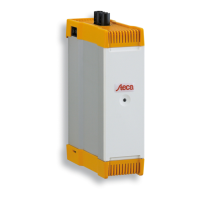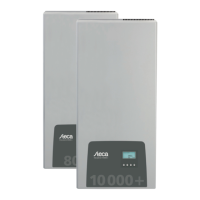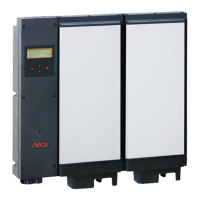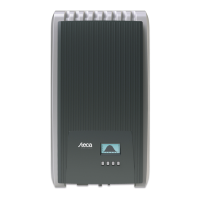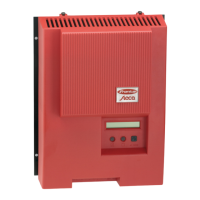What to do if my Steca StecaGrid 3000 Inverter is overheated?
- LLinda Howard MDAug 14, 2025
First, ensure that the installation conditions are correct. If the overheating message appears frequently, contact your installer.
What to do if my Steca StecaGrid 3000 Inverter is overheated?
First, ensure that the installation conditions are correct. If the overheating message appears frequently, contact your installer.
What to do if my Steca Inverter shows 'PV volt. too high'?
Switch off the main DC switch at the inverter and contact your installer.
What should I do if my Steca StecaGrid 3000 displays 'PV current too high'?
If this message occurs frequently, contact your installer.
What should I do if the fan is faulty in my Steca StecaGrid 3000?
Contact your installer to address the faulty fan.
What to do if the self test failed on my Steca StecaGrid 3000 Inverter?
Contact your installer when: - The self-test is canceled due to an error several times at different times of the day and - It is certain that the grid voltage and frequency were within the limit values defined by the country setting.
What should I do if my Steca StecaGrid 3000 displays 'Grid DC offset too high'?
Contact your installer to address the DC offset issue.
What to do if L and N are swapped on my Steca StecaGrid 3000?
Contact your installer to correct the wiring.
What to do if FE is not connected on my Steca StecaGrid 3000?
Contact your installer to connect FE properly.
How to correct the time and date on my Steca StecaGrid 3000 Inverter?
Correct the time and date under Settings / Time/Date.
General identification features of the inverter.
Details about the inverter's identification plate and its components.
Information on how to interpret the display and software versions.
Explains safety symbols and instructions found on the inverter itself.
Overview of the manual's sections.
Defines who the manual is intended for.
Explains symbols, keywords, and text markings used in the manual.
Describes the external components and connections of the inverter casing.
General information on how the inverter display works.
Describes the measurements and symbols shown in the status display.
Overview of menu navigation for date and time settings.
How to view daily, monthly, and annual energy yields.
How to view the total accumulated energy yield.
How to use check boxes for selection lists.
How to use radio buttons for selection lists.
How to respond to general dialogs.
How to change numerical settings like date and remuneration.
How to reset stored maximum values.
How to select measurements for the status display.
Configuration options for the acoustic alarm.
Configuration options for the display backlight.
How to manually limit the inverter's output power.
How to set a fixed input voltage for the inverter.
How to reset the country setting.
How to reset the inverter to factory default settings.
How to adjust voltage disconnection limits.
Overview of reactive power characteristic curve settings.
Technical details of reactive power characteristic curves.
Information on data displayed and stored by the inverter.
Describes the RS485 bus interface and connected devices.
Crucial safety precautions to observe during installation.
How to securely attach the mounting plate.
How to attach the inverter to the mounted plate.
Information on the required line circuit breaker.
Requirements for a residual current circuit breaker.
Instructions for wiring the AC plug.
Explains the conditions and process for initial commissioning.
The step-by-step guided procedure for initial setup.
Instructions for setting the correct country for operation.
How to start the initial commissioning process.
How to select the display language.
How to set the date and time.
How to set the time.
Process for selecting the country.
How to configure reactive power characteristic curves.
Steps to complete the initial commissioning process.
How to safely switch off AC and DC power.
How to disconnect the DC cables.
How to disconnect the AC plug.
How to detach the inverter from its mounting.
A chart illustrating the inverter's menu structure and functions.
How to view the inverter's current status.
How to navigate through the inverter's menus.
How to access and view event messages.
How to view energy yields in list and chart formats.
Explains the prerequisites and function of the self-test.
Steps to perform and interpret the self-test results.
Information on the structure of event messages.
Explains different types of event messages (Information, Warning, Error).
How new event messages are displayed and confirmed.
How to confirm event messages.
Steps to view event messages chronologically.
How to remove dust from the inverter.
How to clean heavy soiling from the inverter.
Technical data for the StecaGrid inverter.
General conditions for product guarantees.
Information on legal and voluntary guarantee periods.
Conditions under which guarantees are void.
General identification features of the inverter.
Details about the inverter's identification plate and its components.
Information on how to interpret the display and software versions.
Explains safety symbols and instructions found on the inverter itself.
Overview of the manual's sections.
Defines who the manual is intended for.
Explains symbols, keywords, and text markings used in the manual.
Describes the external components and connections of the inverter casing.
General information on how the inverter display works.
Describes the measurements and symbols shown in the status display.
Overview of menu navigation for date and time settings.
How to view daily, monthly, and annual energy yields.
How to view the total accumulated energy yield.
How to use check boxes for selection lists.
How to use radio buttons for selection lists.
How to respond to general dialogs.
How to change numerical settings like date and remuneration.
How to reset stored maximum values.
How to select measurements for the status display.
Configuration options for the acoustic alarm.
Configuration options for the display backlight.
How to manually limit the inverter's output power.
How to set a fixed input voltage for the inverter.
How to reset the country setting.
How to reset the inverter to factory default settings.
How to adjust voltage disconnection limits.
Overview of reactive power characteristic curve settings.
Technical details of reactive power characteristic curves.
Information on data displayed and stored by the inverter.
Describes the RS485 bus interface and connected devices.
Crucial safety precautions to observe during installation.
How to securely attach the mounting plate.
How to attach the inverter to the mounted plate.
Information on the required line circuit breaker.
Requirements for a residual current circuit breaker.
Instructions for wiring the AC plug.
Explains the conditions and process for initial commissioning.
The step-by-step guided procedure for initial setup.
Instructions for setting the correct country for operation.
How to start the initial commissioning process.
How to select the display language.
How to set the date and time.
How to set the time.
Process for selecting the country.
How to configure reactive power characteristic curves.
Steps to complete the initial commissioning process.
How to safely switch off AC and DC power.
How to disconnect the DC cables.
How to disconnect the AC plug.
How to detach the inverter from its mounting.
A chart illustrating the inverter's menu structure and functions.
How to view the inverter's current status.
How to navigate through the inverter's menus.
How to access and view event messages.
How to view energy yields in list and chart formats.
Explains the prerequisites and function of the self-test.
Steps to perform and interpret the self-test results.
Information on the structure of event messages.
Explains different types of event messages (Information, Warning, Error).
How new event messages are displayed and confirmed.
How to confirm event messages.
Steps to view event messages chronologically.
How to remove dust from the inverter.
How to clean heavy soiling from the inverter.
Technical data for the StecaGrid inverter.
General conditions for product guarantees.
Information on legal and voluntary guarantee periods.
Conditions under which guarantees are void.
| Rated Output Power | 3000 W |
|---|---|
| Max. apparent AC power | 3000 VA |
| AC voltage range | 180 V - 276 V |
| Max. input voltage | 550 V |
| Maximum DC input voltage | 550 V |
| Maximum input current | 18 A |
| Number of MPP trackers | 1 |
| Nominal AC output power | 3000 W |
| Maximum AC output power | 3000 W |
| Output Voltage | 230 V |
| Nominal AC voltage | 230 V |
| Power factor | > 0.99 |
| Weight | 9.8 kg |
| Warranty | 5 years |
| Maximum DC input power | 3900 W |
| Max. DC power | 3900 W |
| Nominal AC frequency | 50/60 Hz |
| AC frequency range | 47-52 Hz / 57-62 Hz |
| Operating temperature range | -25°C to +60°C |
| Cooling | Convection |
